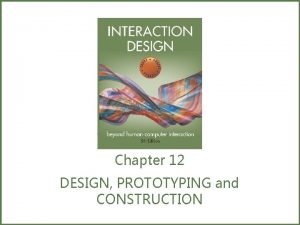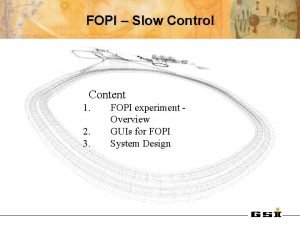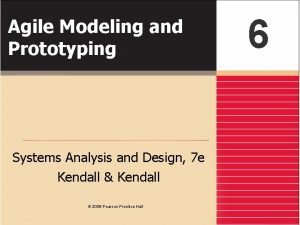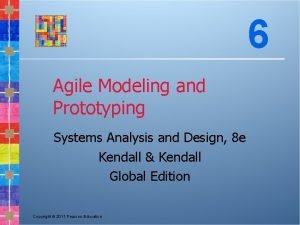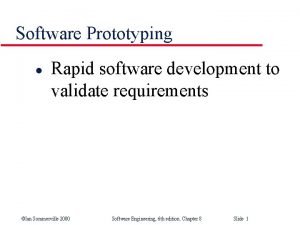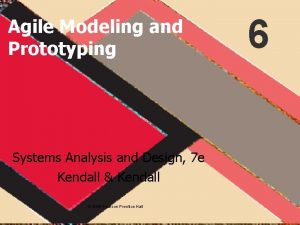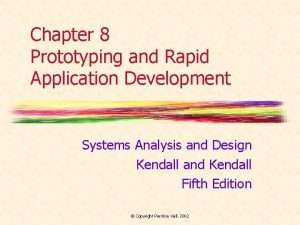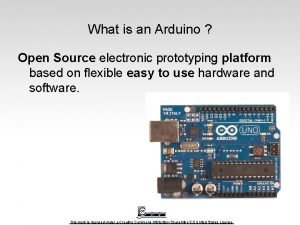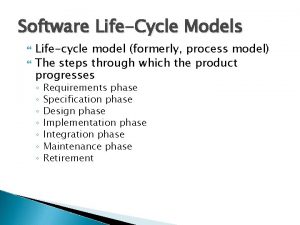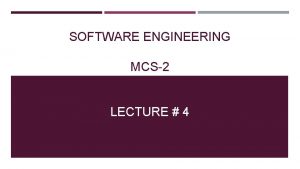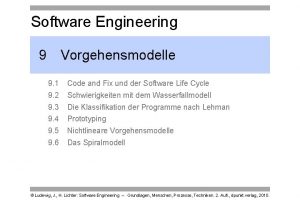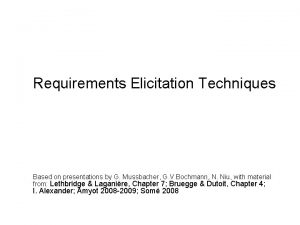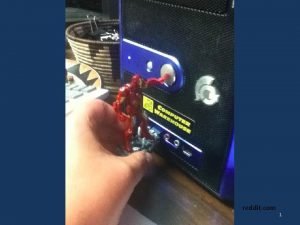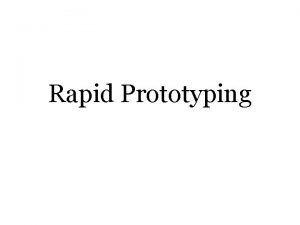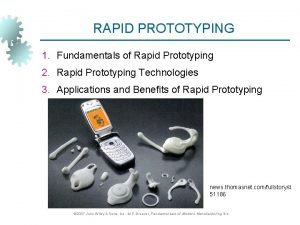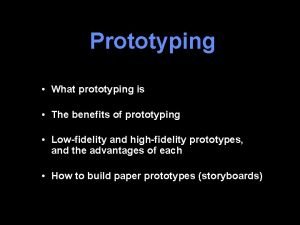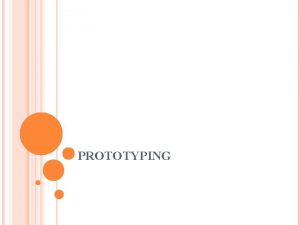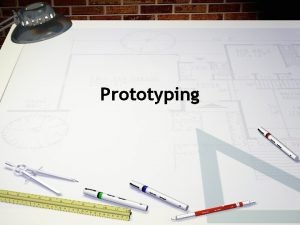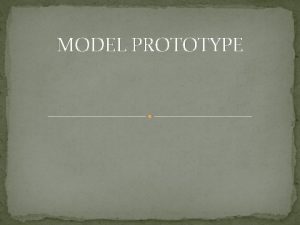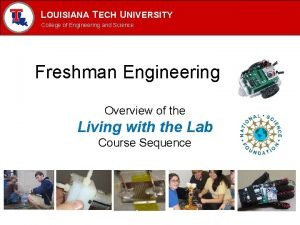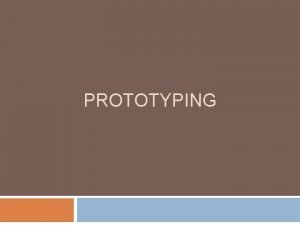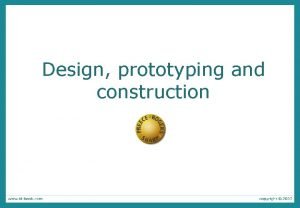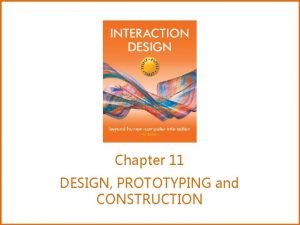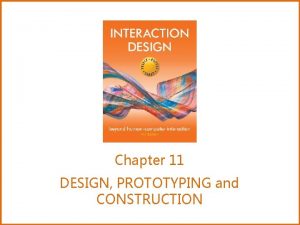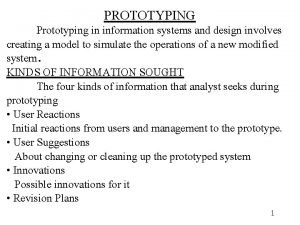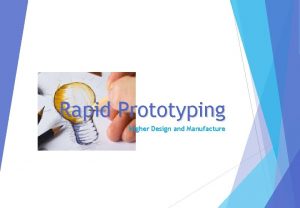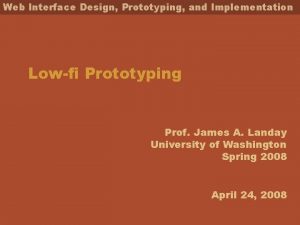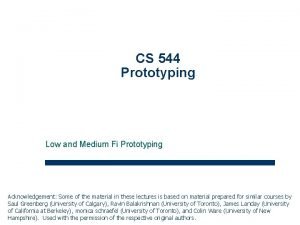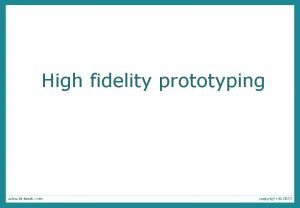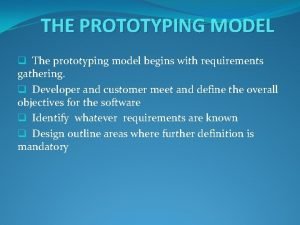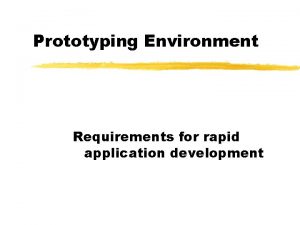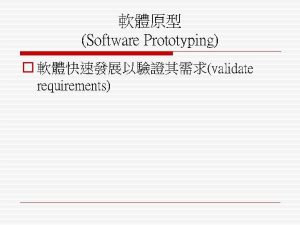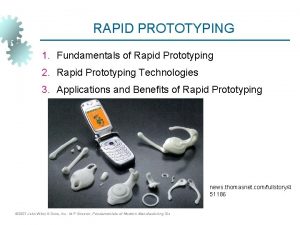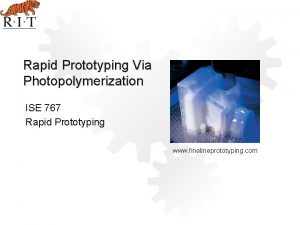Design prototyping and constructionChapter 11 Overview Prototyping and






















- Slides: 22

Design, prototyping and construction(Chapter 11)

Overview • Prototyping and construction • Conceptual design • Physical design • Generating prototypes

What is a prototype? In other design fields a prototype is a small-scale model: • a miniature car • a miniature building or town

What is a prototype? In interaction design it can be (among other things): • a series of screen sketches • a storyboard, i. e. a cartoon-like series of scenes • a Power Point slide show • a video simulating the use of a system • a lump of wood (e. g. Palm. Pilot) • a cardboard mock-up • a piece of software with limited functionality written in the target language or in another language

Why prototype? • Evaluation and feedback are central to interaction design • Stakeholders can see, hold, interact with a prototype more easily than a document or a drawing • Team members can communicate effectively • You can test out ideas for yourself • It encourages reflection: very important aspect of design • Prototypes answer questions, and support designers in choosing between alternatives

What to prototype? • Technical issues • Work flow, task design • Screen layouts and information display • Difficult, controversial, critical areas

Low-fidelity Prototyping • Uses a medium which is unlike the final medium, e. g. paper, cardboard • Is quick, cheap and easily changed • Examples: sketches of screens, task sequences, etc ‘Post-it’ notes storyboards ‘Wizard-of-Oz’

Storyboards • Often used with scenarios, bringing more detail, and a chance to role play • It is a series of sketches showing how a user might progress through a task using the device • Used early in design

Sketching • Sketching is important to low-fidelity prototyping • Don’t be inhibited about drawing ability. Practice simple symbols

Card-based prototypes • • Index cards (3 X 5 inches) Each card represents one screen or part of screen Often used in website development Card-based prototypes can be generated from use cases

‘Wizard-of-Oz’ prototyping • The user thinks they are interacting with a computer, but a developer is responding to output rather than the system. • Usually done early in design to understand users’ expectations • What is ‘wrong’ with this approach? User >Blurb blurb >Do this >Why?

High-fidelity prototyping • Uses materials that you would expect to be in the final product. • Prototype looks more like the final system than a lowfidelity version. • For a high-fidelity software prototype common environments include Macromedia Director, Visual Basic, and Smalltalk. • Danger that users think they have a full system……. see compromises

Compromises in prototyping • All prototypes involve compromises • For software-based prototyping maybe there is a slow response? sketchy icons? limited functionality? • Two common types of compromise • ‘horizontal’: provide a wide range of functions, but with little detail • ‘vertical’: provide a lot of detail for only a few functions • Compromises in prototypes mustn’t be ignored. Product needs engineering

Construction • Taking the prototypes (or learning from them) and creating a whole • Product must be engineered Evolutionary prototyping ‘Throw-away’ prototyping

Conceptual design: from requirements to design • Transform user requirements/needs into a conceptual model “an outline of what people can do and how to interact with it” • Don’t move to a solution too quickly. Iterate, iterate • Consider alternatives: prototyping helps

Guiding Principles • • Keep an open mind, but never forget the user Discuss ideas with all stakeholders Low fidelity prototyping Iterate, Iterate

Is there a suitable metaphor? • Interface metaphors combine familiar knowledge with new knowledge in a way that will help the user understand the product. • Three steps: • understand functionality, • identify potential problem areas, • generate metaphors

Evaluate metaphors • • • How much structure does it provide? How much is relevant to the problem? Is it easy to represent? Will the audience understand it? How extensible is it?

Considering interaction types • Which interaction type? How the user invokes actions Instructing, conversing, manipulating or exploring • Do different interface types provide insight? WIMP, shareable, augmented reality, etc

Expanding the conceptual model • What functions will the product perform? What will the product do and what will the human do (task allocation)? • How are the functions related to each other? Sequential or parallel? Categorisations • What information needs to be available? What data is required to perform the task? How is this data to be transformed by the system?

Reading Assignment • Read Chapter 11 in the ID book

Summary • Different kinds of prototyping are used for different purposes and at different stages • Prototypes answer questions, so prototype appropriately • Construction: the final product must be engineered appropriately • Conceptual design (the first step of design) • Consider interaction types and interface types to prompt creativity
 Design prototyping and construction
Design prototyping and construction System design
System design System design overview
System design overview Patched up prototype
Patched up prototype Agile modeling and prototyping
Agile modeling and prototyping Rapid software prototyping
Rapid software prototyping Agile modeling and prototyping
Agile modeling and prototyping Rapid application development prototyping
Rapid application development prototyping Open source electronics prototyping platform
Open source electronics prototyping platform Méduce
Méduce Object oriented life cycle model
Object oriented life cycle model Prototyping process in software engineering
Prototyping process in software engineering Prototyping vorgehensmodell
Prototyping vorgehensmodell Prototyping elicitation technique
Prototyping elicitation technique Prototype reddit
Prototype reddit Rapid prototype definition
Rapid prototype definition Liquid based rapid prototyping system
Liquid based rapid prototyping system Benefits of prototyping
Benefits of prototyping Prototyping definition
Prototyping definition Prototyping involve compromises
Prototyping involve compromises Gambar model prototyping
Gambar model prototyping Predictive maintenance wikipedia
Predictive maintenance wikipedia Louisiana tech university engineering
Louisiana tech university engineering
